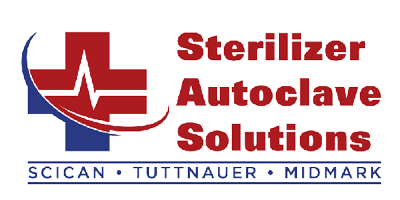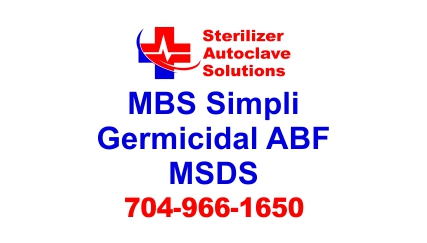MBS Simpli Germicidal ABF Wipes MSDS Leave a comment
This article contains the medical safety data sheet information for the MBS Simpli Germicidal Wipes. And if you just want to talk to someone, call our Free Tech Support at 704-966-1650 Option 3.
MBS SIMPLI GERMICIDAL WIPES MATERIAL SAFETY DATA SHEET
SECTION 1. IDENTIFICATION
Product Name: MBS MedTech 1839-174-xxxxx Wipes (6” x 6.75” and 8” x 14”)
Manufacturer: MBS Medical Technologies; 6750 North Desert Blvd.; El Paso, TX 79912
In Emergency call 911.
For Information about this SDS, contact Chemtrec: 800-424-9300
For information about the product: 888-482-4201
SECTION 2. HAZARDS IDENTIFICATION
Hazard Classifications:
Eye irritation – category 2B
Flammable liquid – category 4
Signal Word(s): Warning
Hazard Statements:
Causes eye irritation
Combustible liquid
Toxic to aquatic life with long lasting effects
Pictograms
None
Precautionary Statements:
Keep away from heat/sparks/open flames/hot surfaces. – No smoking.
Wash thoroughly after handling
Avoid release to the environment
Wear protective gloves/eye protection/face protection.
Keep out of reach of children
Store in a well-ventilated place
Precautionary Statements – Response:
In case of fire: Use appropriate media to extinguish.
If inhaled: remove person to fresh air and keep comfortable for breathing.
If skin irritation persists, get medical attention.
If in eyes: rinse cautiously with water for several minutes.
Remove contact lenses if present and easy to do. Continue rinsing.
If eye irritation persists: Get medical advice/attention.
Precautionary Statements – Storage:
Store in a cool well-ventilated area. Keep cool.
SECTION 3. COMPOSITION/INFORMATION ON INGREDIENTS
| Chemical Name | Synonym | CAS# | Conc. |
|---|---|---|---|
| Tetra sodium ethylene tetra acetic acid | Tetra sodium edetate | 64-02-8 | 1-<3% |
| Quaternary ammonium compounds | n-Alkyl-(C12-C18)-dimethylbenzyl ammonium chlorides | 68391-01-5 | <0.2% |
| Quaternary ammonium compounds | n-Alkyl-(C12-C14)-dimethyl-ethylbenzyl ammonium chlorides | 85409-23-0 | <0.2% |
| Other components below reportable levels | 90-100% |
SECTION 4. FIRST-AID MEASURES
After Skin Contact:
Flush skin with plenty of water for 15 minutes while removing contaminated clothing.
After Eye Contact:
Flush eyes with water for 15 minutes while holding eyelids open. Get medical attention.
After Inhalation:
Remove to fresh air. If breathing is difficult seek medical attention. Eliminate all ignition sources if safe to do so.
After Swallowing:
Do NOT induce vomiting. Rinse out mouth with clean water. Get immediate medical attention.
SECTION 5. FIRE-FIGHTING MEASURES
Suitable extinguishing agents: Dry chemical, foam, carbon dioxide (CO2) or water fog is recommended to cool or protect exposed materials or structures. Carbon dioxide can displace oxygen. Use caution when applying carbon dioxide in confined spaces. Simultaneous use of foam and water on the same surface should be avoided as water destroys the foam. Sand or earth may be used for small fires only.
Special Protective Equipment for firefighters: Isolate immediate hazard area and keep unauthorized personnel out. Stop spill/release if it can be done safely. Move undamaged containers from immediate hazard area if it can be done safely. Water spray may be useful in minimizing or dispersing vapors and to protect personnel.
SECTION 6. ACCIDENTAL RELEASE MEASURES
Personal precautions: Keep Unnecessary personnel away. Avoid contact with skin, eye or clothing. Eliminate all ignition sources (no smoking, flares, sparks or flames in immediate area). Use explosive proof equipment. Do not touch damaged containers or spilled materials unless wearing appropriate protective clothing.
Measures for environmental protection: Stop spill release if it can be done safely. Prevent spilled materials from entering sewers, storm drains, other unauthorized drainage systems and natural waterways by using sand, earth or other appropriate barriers.
Measures for cleaning/collecting: Sand, clay and absorbent socks can be used to contain a spill. Never return spills to original containers for re-use.
SECTION 7. HANDLING AND STORAGE
Handling: Keep away from open flames. Wash hands thoroughly after handling. Avoid contact with eyes, skin, and clothing. Eyewash stations should be available where material is stored. Maintain adequate ventilation. Do not empty into drains.
Storage: Keep containers tightly closed and properly labeled. Store in cool, dry, well-ventilated areas away from heat, direct sunlight. Store in original or approved containers and protect against physical damage. Keep containers securely sealed to prevent leakage. Use non-sparking ventilation systems.
SECTION 8. EXPOSURE CONTROLS/PERSONAL PROTECTION
| Chemical Name | OSHA TWA | NIOSH STEL | ACGIH OEL (TWA) | ACGIH OEL (STEL) |
|---|---|---|---|---|
| Diethylene Glycol Monobutyl Ether | no limits | no limits | 10 ppm | no limits |
| Tetra Sodium EDTA | no limits | no limits | no limits | no limits |
| Quaternary ammonium compounds | no limits | no limits | no limits | no limits |
Respiratory Protection: If engineering controls do not maintain airborne concentrations to a level which is adequate to protect worker, a respiratory protection program that meets or is equivalent to OSHA 29CFR 1910.134 and ANSI Z88.2 should be followed. Check with respiratory protective equipment suppliers. Select a filter suitable for organic gases and vapors (boiling point 65°C; 149°F) meeting EN371.
Skin Protection: Use of gloves approved to relevant standards made from the following materials may provide suitable chemical protection: PVC, neoprene or nitrile rubber.
Eye Protection: Wear eye protection with side-shields or goggles. Wear indirect-vent, impact and splash resistant goggles when working with liquids. If additional protection is needed for entire face, using in combination with a face shield.
Appropriate Engineering Controls: Good general ventilation (typically 10 air changes per hour) should be used. Ventilation rates should be matched to conditions. If applicable, use process enclosures, local exhaust ventilation, or other engineering controls to maintain airborne levels below recommended exposure limits. If exposure limits have not been established, maintain airborne levels to an acceptable level. Provide eyewash station.
SECTION 9. PHYSICAL AND CHEMICAL PROPERTIES
Form: liquid-soaked wipe
Odor: n/a
Odor threshold: n/a
pH: 11.7
Melting point/melting range: n/a
Boiling point/boiling range: n/a
Flash point: >93.9°C / >201.0°F
Evaporation rate: n/a
Flammability: n/a
Upper/lower flammability or explosive limits: n/a
Auto ignition temperature: n/a
Vapor pressure: n/a
Vapor density: n/a
Relative density: 1.004 (water = 1)
Density: 8.38 lb/gal
Solubility in/Miscibility with water: highly soluble
SECTION 10. STABILITY AND REACTIVITY
Chemical Stability: stable under normal conditions of use
Conditions to avoid: heat, sparks, open flames and other ignition sources
Incompatible Materials: strong oxidizing agents
Hazardous Decomposition Products: thermal decomposition may yield oxides of nitrogen and ammonia, carbon dioxide, carbon monoxide and other low molecular weight hydrocarbons
SECTION 11. TOXICOLOGICAL INFORMATION
Potential routes of exposure/potential health effects
Skin: can cause mild skin irritation.
Eye: causes serious eye irritation.
Inhalation: prolonged inhalation may be harmful.
Ingestion: may be harmful or fatal if swallowed.
Carcinogenic effects: no data available.
Mutagenic effects: no data available.
Reproductive toxicity: not expected to cause reproductive or developmental effects.
Sensitization: no data available.
Target organs: eyes.
SECTION 12. ECOLOGICAL INFORMATION (non-mandatory)
Ecotoxicity: Toxic to aquatic life. Harmful to aquatic life with long lasting effects.
Mobility in soil: no data available.
Biodegradation: no data available.
Bioaccumulation: no data available.
Partition coefficient n-octanol/water (log Kow) – Diethylene glycol monobutyl ether 0.56
SECTION 13. DISPOSAL CONSIDERATIONS (non-mandatory)
Waste must be disposed of in full compliance with federal, state and local environmental regulations.
SECTION 14. TRANSPORT INFORMATION (non-mandatory)
DOT regulations: : NA1993, COMBUSTABLE LIQUID, N.O.S. (Ethanol)
- Hazard class: 3
Special Provisions for Transport: not available.
SECTION 15. REGULATORY INFORMATION
US Federal and State Regulations
SARA Section 355 (extremely hazardous substances): none
SARA Section 313 (specific toxic chemical listings): none
Clean Air Act, Section 112 Hazardous Air Pollutants (HAPs): none
Connecticut hazardous material survey.: Isopropyl alcohol; Illinois toxic substances disclosure to employee act: Isopropyl alcohol; Rhode Island RTK hazardous substances: Isopropyl alcohol; Pennsylvania RTK: Isopropyl alcohol; Florida: Isopropyl alcohol; Minnesota: Isopropyl alcohol Massachusetts RTK: Isopropyl alcohol; New Jersey: Isopropyl alcohol New Jersey spill list: Isopropyl alcohol; TSCA 8(b) inventory: Isopropyl alcohol; Water TSCA 4(a) final testing order: Isopropyl alcohol TSCA 8(a) IUR: Isopropyl alcohol TSCA 8(d) H and S data reporting: Isopropyl alcohol: Effective date: 12/15/86 Sunset Date: 12/15/96 TSCA 12(b) one time export: Isopropyl alcohol SARA 313 toxic chemical notification and release reporting: Isopropyl alcohol
Other Classifications:
WHMIS (Canada):
CLASS B-2: Flammable liquid with a flash point lower than 37.8°C (100°F). CLASS D-2B: Material causing other toxic effects (TOXIC).
DSCL (EEC):
R11- Highly flammable. R36- Irritating to eyes. S2- Keep out of the reach of children. S46- If swallowed, seek medical advice immediately and show this container or label.
HMIS (U.S.A.):
Health Hazard: 2
Fire Hazard: 3
Reactivity: 0
Personal Protection: E
National Fire Protection Association (U.S.A.):
Health: 1
Flammability: 3
Reactivity: 0
SECTION 16. OTHER INFORMATION
SDS date of preparation/update: 01 December 2020 / 01 December 2020
As always if you have any questions about this process or anything else please feel free to contact us and take advantage of our “FREE TECH SUPPORT.”
We also offer FREE VIRTUAL TECH SUPPORT to “See and Talk” with a “Real Time Live Technician” for any problems you may be in need of help with.
You can also use our “FREE MAINTENANCE PROGRAM”. Take the guesswork and worrying about what unit is due for maintenance and which maintenance cycle it is time for. We will keep track of all your autoclaves and let you know when it’s time for anything.


